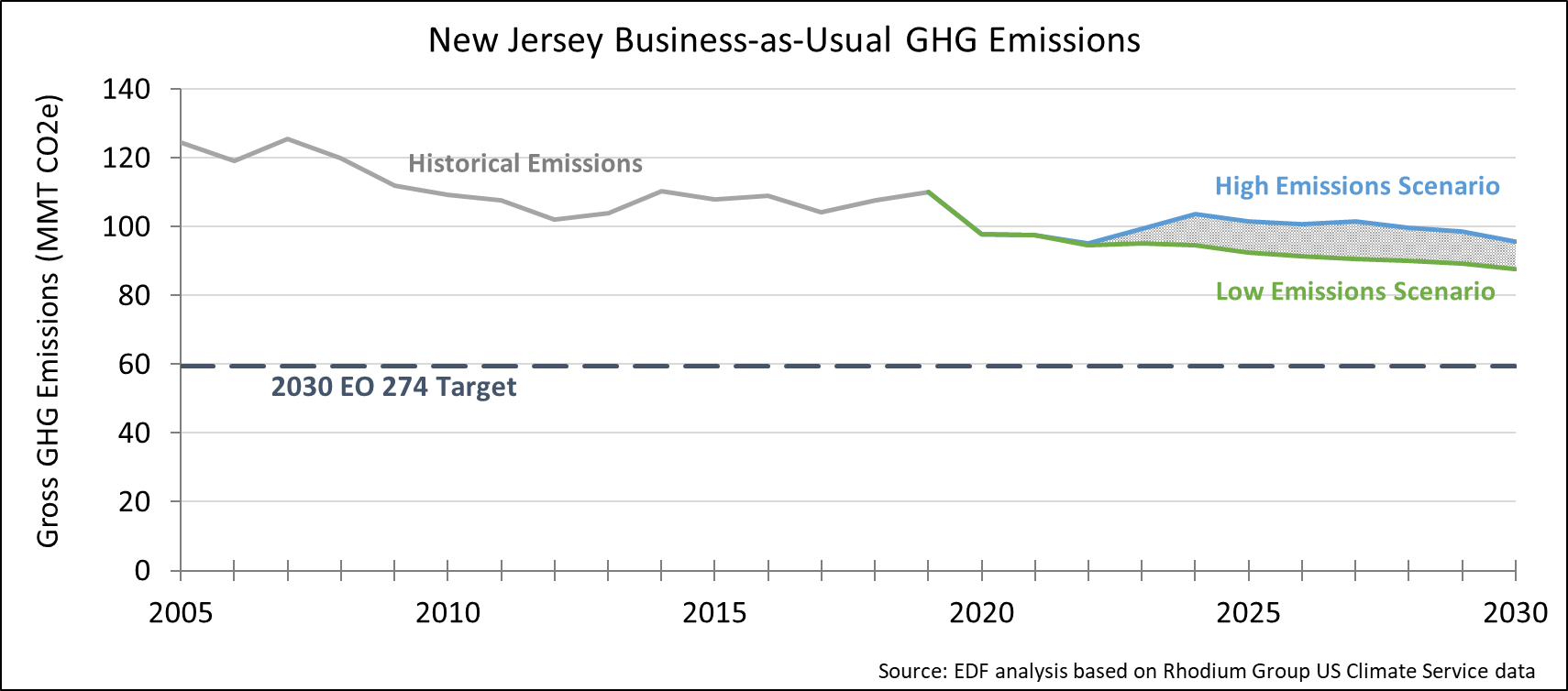
Governor Murphy’s 2030 climate goal demands a new climate game plan for New Jersey
Last month, Governor Phil Murphy elevated New Jersey’s fight against the climate crisis this decade by signing Executive Order No. 274, which commits the state to reducing greenhouse gas emissions 50% below 2006 levels by 2030. The Governor’s action is a critical step toward putting New Jersey on a path to do what is necessary to avoid the worst effects of climate change, and it aligns the state’s goals with those of the Biden administration. It also arrives at a crucial time, after New Jersey communities were hit with destructive flooding and tornadoes from Hurricane Ida earlier this fall and have been forced to confront the reality of increasingly severe and frequent storms.
But Governor Murphy’s climate legacy will not be secured by this commitment. It will be determined by the action he takes to deliver on it. Now that the goal to halve emissions by 2030 across all sectors of the state’s economy has been established as the formal policy of the state of New Jersey, Murphy will need to develop a policy framework that secures emission reductions in line with the target.
The Murphy administration will need to move expeditiously to put this framework in place. An EDF analysis released last year found that New Jersey was not on track to meet its established targets without additional policies to reduce climate pollution – and updated analysis based on more recent data, illustrated in the figure below, shows that the 2030 target established through this order will require more urgent action.

As part of the effort to achieve the state’s climate goals, the New Jersey Department of Environmental Protection also recently proposed a rule to reduce emissions from power plants by limiting the amount of carbon dioxide released for every megawatt hour (MWh) of electricity produced. Other policies New Jersey has in place include:
- A renewable portfolio standard requiring 50% of electricity sold in the state to come from renewable sources by 2030
- Participation in the Regional Greenhouse Gas Initiative (RGGI), which places a declining limit on carbon dioxide emissions from electricity generation
- Energy efficiency standards
- Standards for low- and zero-emission vehicles sales
Performance-based measures like these are positive steps toward reducing the climate impact of our energy systems, and each of them is included in the projections presented above. But these measures alone cannot guarantee the needed reductions will be achieved. A comprehensive policy framework that limits GHG emissions across the economy, working hand-in-hand with sectoral performance-based targets to provide a backstop, is needed to ensure emissions targets are achieved.
Achieving the state’s goals will require a comprehensive approach that directly targets – and firmly limits – climate pollution
To avoid the most damaging impacts of climate change, like more frequent flooding and heat waves, we must rapidly reduce the amount of climate-warming gases released into the atmosphere driving these changes. The best way to do that is with a policy framework that directly targets climate pollution. A program that puts a binding, declining limit on emissions, such as a cap-and-invest policy, provides certainty over time that emissions will decline persistently and consistently over the next decade at the pace and scale needed.
Pollution limits can target individual sources or specific sectors (as RGGI does for electricity generation), or limits can include multiple sectors, even capping emissions across the entire economy. The most important aspect of a program that targets climate pollution is that there is a firm, declining limit that guarantees the reductions are achieved. Pollution limits should include both short-term and long-term targets to ensure immediate and persistent reductions and constrain total allowable pollution.
Any climate policy must be designed with equity as a priority. If well-designed, a cap-and-invest approach can deliver reductions in global emissions as well as address locally harmful air pollution in overburdened communities. For example, the program can include requirements for monitoring air quality, identifying communities with disproportionately high cumulative pollution burdens, and directly reducing local air pollution in those communities alongside greenhouse gas emissions. Environmental justice legislation passed last year in New Jersey already lays the groundwork for identifying overburdened communities, which can be incorporated into any comprehensive climate regulation. For example, facilities that are contributing to cumulative pollution burden in these communities could face more stringent compliance obligations (e.g. directly limiting total emissions for individual facilities), or could be restricted from taking advantage of certain compliance flexibilities.
Importantly, a policy framework should be designed to dramatically accelerate near-term reductions—which can be done by pairing limits on pollution with a price on pollution. Providing a clear price signal will also catalyze clean investments and spur the innovation necessary to make the deep cuts in pollution necessary after 2030. A price on emissions can help enable greater ambition by securing the most-cost effective reductions first and lowering overall compliance costs, enabling faster reductions on a shorter timeline. For instance, cap-and-invest programs that use allowance markets can cover all emissions across the economy under one limit, and even link with other markets to improve efficiency and expand opportunities for cost-effective cuts in emissions.
Establishing an overarching cap on climate pollution is uniquely effective for achieving emission reductions because of its coverage of all major polluters in the state, and because of the certainty such a limit will provide. This enables the administration to set pollution reduction targets it can be confident in achieving.
The Murphy administration should also work to improve the sector-specific limits already in place. In particular, as the Regional Greenhouse Gas Initiative begins its Third Program Review, Governor Murphy should work with other RGGI states to establish a cap on regional power sector pollution in line with what is required from the power sector to achieve New Jersey’s climate goals – at least an 80% reduction from 2005 levels by 2030. Nationally, analyses have shown that reducing emissions from electricity generation by at least 80% by 2030 is critical in achieving a 50% reduction in emissions across the economy by 2030.
Ensuring equity in program design
New Jersey must ensure that their approach to meeting climate targets directs environmental and economic benefits to communities that are disproportionately burdened with environmental harms and health impacts. Binding, declining limits on all the state’s major sources of emissions can also reduce local air pollution by reducing the combustion of fossil fuels, with the potential to provide significant health benefits. Prioritizing equity in program design can help ensure that critical air quality improvements and clean energy investments materialize in the communities that need them most. And it can constrain potential adverse impacts by placing more stringent compliance obligations on emitters with ongoing operations in these communities.
Funding generated by requiring polluters to pay for their emissions must provide direct and meaningful benefits to these communities, such as by supporting climate resilience, air quality improvements, better transportation options and job creation. And investment decisions should be guided by environmental justice assessments and by advisory bodies that represent frontline and disproportionately impacted communities.
Such a program must follow a robust public engagement process to identify and implement policies that help secure benefits from climate policies.
Following Washington state’s cap-and-invest model
Earlier this year, Washington state adopted a cap-and-invest program that puts the most ambitious limit on emissions in the country. Washington is widely seen as a potential model for climate leadership states across the country. Importantly, Washington’s Climate Commitment Act (CCA) sets a new gold standard for climate policy by putting an enforceable, declining limit on all major sources of climate pollution across the state’s economy, while providing new tools to address local air pollution.
New Jersey can look to CCA’s crucial design elements when planning its own approach, like regular program reviews, the potential to link with other markets, measures to ensure that pollution declines in overburdened communities, a requirement to invest at least 35% of program revenues in communities disproportionately burdened by environmental harms, and an environmental justice council to guide program design and implementation.
Governor Murphy has made the right move to protect New Jersey communities by committing to lower dangerous climate pollution 50% this decade, but it will take serious work to follow through on this commitment. Developing a comprehensive policy approach that secures critical pollution reductions will be critical for meeting these climate targets, while also delivering good-paying clean energy jobs, reducing harmful pollution that disproportionately impacts New Jersey’s low-income communities and communities of color, and lowering energy costs.












